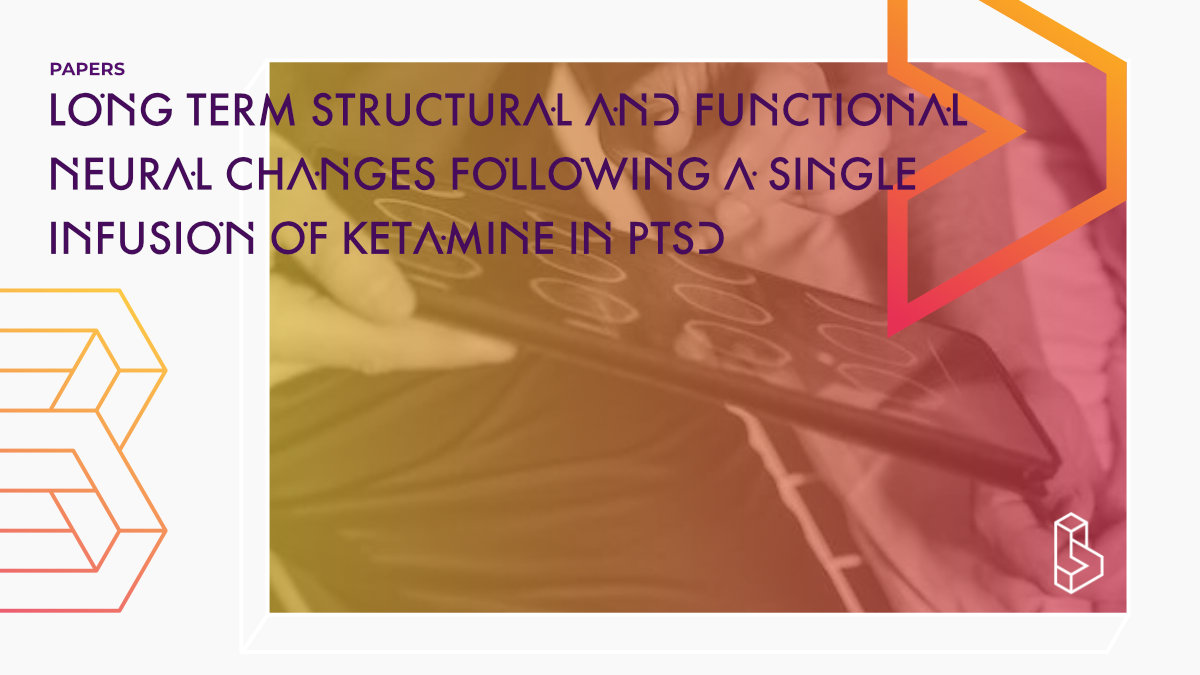This pilot RCT study (n=27) investigated the potential of a single ketamine infusion (35mg/70kg), followed by brief exposure therapy, to enhance the extinction of trauma memories in individuals diagnosed with PTSD. Participants were randomly assigned to receive either ketamine or midazolam after retrieval of the traumatic memory, and underwent trauma-focused psychotherapy 24 hours later for four days. While PTSD symptoms improved equally in both groups, post-treatment ketamine recipients showed lower amygdala and hippocampus reactivation to trauma memories than midazolam recipients, suggesting that ketamine may enhance the post-retrieval extinction of trauma memories.
Abstract of Long term structural and functional neural changes following a single infusion of Ketamine in PTSD
“NMDA receptor antagonists have a vital role in extinction, learning, and reconsolidation processes. During the reconsolidation window, memories are activated into a labile state and can be reconsolidated in an altered form. This concept might have significant clinical implications in treating PTSD. In this pilot study we tested the potential of a single infusion of ketamine, followed by brief exposure therapy, to enhance post-retrieval extinction of PTSD trauma memories. 27 individuals diagnosed with PTSD were randomly assigned to receive either ketamine (0.5 mg/kg 40 min; N = 14) or midazolam (0.045 mg/kg; N = 13) after retrieval of the traumatic memory. 24 h following infusion, participants received a four-day trauma-focused psychotherapy. Symptoms and brain activity were assessed before treatment, at the end of treatment, and at 30-day follow-up. Amygdala activation to trauma scripts (a major biomarker of fear response) served as the main study outcome. Although PTSD symptoms improved equally in both groups, post-treatment, ketamine recipients showed a lower amygdala (−0.33, sd = 0.13, 95%HDI [−0.56,−0.04]) and hippocampus (−0.3 (sd = 0.19), 95%HDI [−0.65, 0.04]; marginal effect) reactivation to trauma memories, compared to midazolam recipients. Post-retrieval ketamine administration was also associated with decreased connectivity between the amygdala and hippocampus (−0.28, sd = 0.11, 95%HDI [−0.46, −0.11]), with no change in amygdala-vmPFC connectivity. Moreover, reduction in fractional anisotropy in bi-lateral uncinate fasciculus was seen in the Ketamine recipients compared with the midazolam recipients (right: post-treatment: −0.01108, 95% HDI [−0.0184,−0.003]; follow-up: −0.0183, 95% HDI [−0.02719,−0.0107]; left: post-treatment: −0.019, 95% HDI [−0.028,−0.011]; follow-up: −0.017, 95% HDI [−0.026,−0.007]). Taken together it is possible that ketamine may enhance post-retrieval extinction of the original trauma memories in humans. These preliminary findings show promising direction toward the capacity to rewrite human traumatic memories and modulate the fear response for at least 30 days post-extinction. When combined with psychotherapy for PTSD, further investigation of ketamine dose, timing of administration, and frequency of administration, is warranted.”
Authors: Or Duek, Nachshon Korem, Yutong Li, Ben Kelmendi, Shelley Amen, Charles Gordon, Madison Milne, John H. Krystal, Ifat Levy & Ilan Harpaz-Rotem
Summary of Long term structural and functional neural changes following a single infusion of Ketamine in PTSD
Reactivating a stored memory may change its state from consolidated into a labile, in which its content or meaning may be altered. This process is especially relevant to post-traumatic stress disorder (PTSD).
When neutral cues are paired with aversive outcomes, fear responses are acquired. Extinction is likely achieved through inhibition of amygdala fear responses by the ventromedial prefrontal cortex (vmPFC), but post-retrieval extinction may involve modification of the original memory.
Functional connectivity between the amygdala and hippocampus was associated with the return of fear, and anatomical connectivity was found to play a role in fear conditioning.
Find this paper
Long term structural and functional neural changes following a single infusion of Ketamine in PTSD
https://doi.org/10.1038/s41386-023-01606-3
Open Access | Google Scholar | Backup | 🕊
Cite this paper (APA)
Duek, O., Korem, N., Li, Y. et al. Long term structural and functional neural changes following a single infusion of Ketamine in PTSD. Neuropsychopharmacology (2023). https://doi.org/10.1038/s41386-023-01606-3
Study details
Compounds studied
Ketamine
Topics studied
PTSD
Neuroscience
Study characteristics
Placebo-Controlled
Double-Blind
Randomized
Participants
27
Humans
Compound Details
The psychedelics given at which dose and how many times
Ketamine 35 mg | 1x
